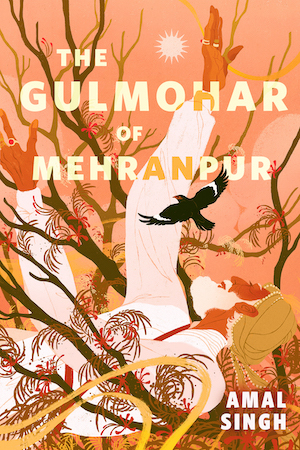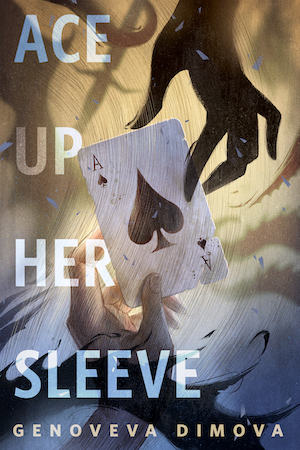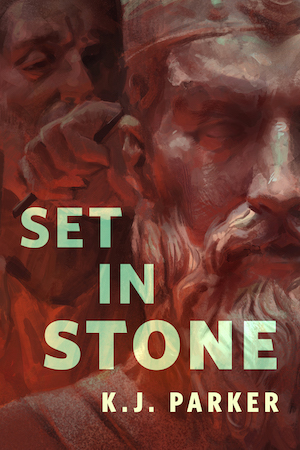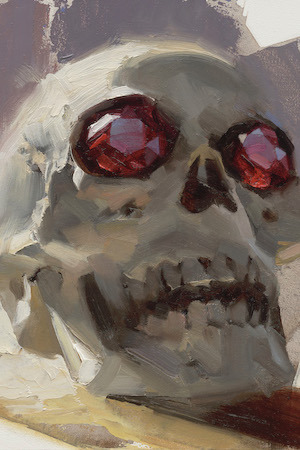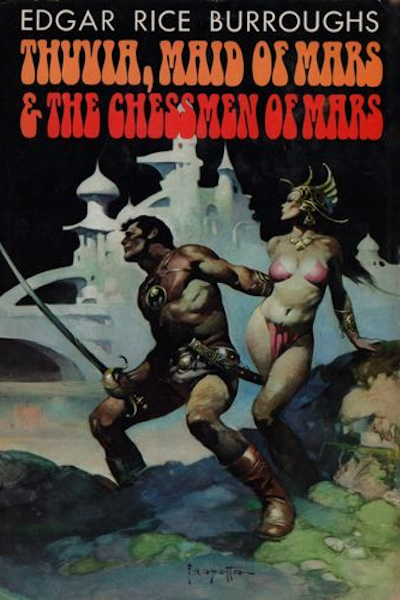In this bi-weekly series reviewing classic science fiction and fantasy books, Alan Brown looks at the front lines and frontiers of the field; books about soldiers and spacers, scientists and engineers, explorers and adventurers. Stories full of what Shakespeare used to refer to as “alarums and excursions”: battles, chases, clashes, and the stuff of excitement.
Even though the days are waning and the first chill of autumn is in the air, I decided there is still time for a little more pulpy summer adventure reading. I recently reviewed books two and three of Edgar Rice Burroughs’ Barsoom series, featuring the famous John Carter of Mars, and had so much fun that I decided to push on and read books four and five of the series, Thuvia, Maid of Mars and The Chessmen of Mars. These books bring Carter’s son and daughter to center stage, but still offer the same entertaining mix of exciting pulp adventures and strange aliens that made the preceding novels so enjoyable.
When I picked up the first three books of the Barsoom series, I found that during my youth, despite thinking I had read the entire series, I had only read the first two of the three. And looking at these next two books, I realized that I had not read the fourth book, but had read the fifth. (Books were harder to come by in my youth, and my brothers and I read what we could put our hands on, regardless of series order.)
Despite the voluminous collection hiding in my basement, I could find neither of these two books. So I went to the internet and purchased a used copy of an omnibus edition from the Science Fiction Book Club that collected both books, packaged them in a gorgeous wrap-around dust jacket illustrated by Frank Frazetta, and featured interior pen and ink illustrations also by Frazetta. The book does not contain a publication date, but the illustrations were copyrighted in 1972, so I imagine the volume was printed around that time.
Although Burroughs finished Thuvia, Maid of Mars in 1914, due to personnel changes at his publisher, the story did not appear until 1916, when it was serialized in All-Story Weekly in three parts. The Chessmen of Mars was originally serialized in six issues of Argosy All-Story Weekly in 1922.
About the Author
Edgar Rice Burroughs (1875-1950) was one of the most popular authors of the early 20th century, making an indelible mark on both science fiction and adventure fiction. I’ve looked at his work in this column before, including A Princess of Mars, The Gods of Mars and The Warlord of Mars, the book Pirates of Venus and the rest of the Venus series, and also Tarzan at the Earth’s Core and the other Pellucidar books. All those articles contain more biographical information on the author, and my review of the first Barsoom book also includes a discussion of John Carter’s adventures in other media, including movies and comic books. You can find much of Burroughs’ work available to read for free at Project Gutenberg, including most of the Barsoom series.
Jumping the Shark
It can be difficult to keep a long series going, and readers engaged, whether the media be the written word, television, or movies. There are tried and true strategies—you can bring in new characters, new situations, new twists, new monsters, new technology, and new powers and abilities. In planetary romance stories, such as the Barsoom series, there are always new lost cities to be discovered, although even that can sometimes feel like more of the same. In a recent review of E.E. “Doc” Smith’s Skylark of Valeron, I pointed out his tendency to go overboard as he added new books to both the Skylark and Lensman series. He had a tendency to expand the size of his ships, the power of his weapons, and the mental abilities of his characters to the point where the narrative was transformed beyond recognition. With the infinite possibilities of science fiction, there are no real guardrails to keep an author in check…but when you drastically change the scope and feel of a story, it is easy to lose the interest of the readers who enjoyed earlier installments.
The classic example of a series that left its audience behind is the TV series Happy Days, which ran over eleven seasons from 1974 to 1984, a humorous sitcom that featured a family centered around a teenager played by Ron Howard, who was friendly with local motorcycle-riding “tough guy” Fonzie, played by Henry Winkler. As viewership waned over time, the show featured Fonzie more and more, losing its family-oriented charm, until (as many of you may know) there was an episode in which Fonzie went waterskiing, and jumped over an enclosure containing a shark. The emphasis on Fonzie and that infamously over-the-top episode might have briefly renewed interest in the show, but Happy Days was never the same, and the stunt gave rise to the pop culture term “jumping the shark.”
Edgar Rice Burroughs faced similar challenges in his various series over the years. In the fourth and fifth installments of the Barsoom series, which I’m looking at today, he switched things up by featuring the son and daughter of John Carter, star of the original trilogy of books. He also sent them to strange new cities on Mars in an effort to spice things up. But he also populated one city with people in possession of mental powers so potent that they could conjure images of bowmen so convincing that their arrows can slay opponents. Another city is inhabited by heads and bodies that evolved separately, but which could join together to produce a hideous imitation of a human being. Those certainly bring some eye-opening new ideas to the tales of Barsoom, but to me feel as if Burroughs, years before the term was coined, might just have jumped the shark himself.
Thuvia, Maid of Mars
This book shifts the story to a new generation of adventurers who had been introduced in prior novels. First is Carthoris, the son of Warlord of Mars John Carter, who has inherited the strength and fighting prowess of his father (apparently Burroughs subscribed to the now-debunked theory that acquired traits could be inherited). And the second is the beautiful Thuvia of Ptarth, who has the handy ability to commune with the fierce banth, the Martian equivalent of lions.
Thuvia has been kidnapped by the evil minions of Prince Astok of Dusar, who had made crude advances toward Thuvia, only to be rebuffed. But many in Ptarth have seen that Carthoris is also smitten by Thuvia, and he is immediately a suspect. The honor of princesses is highly valued on Barsoom, and their mistreatment can bring nations to war. So, John Carter orders Carthoris to find Thuvia, a task the young man gladly takes on.
Carthoris rescues Thuvia from Green Martian warriors, who had stolen her from her original captors. She is suspicious, as she suspects those men were working for Carthoris. But their freedom is short-lived, because both fall into the hands of people from the lost city of Lothar. The Lotharians are telepaths whose favorite trick, as noted above, is to create phantom armies of bowmen, phantoms so convincing they can kill with power of suggestion. The Lotharians also use banths, but Thuvia’s powers over these creatures keep her and Carthoris safe. At one point in the narrative, stretching the idea of telepathic powers past the point of credulity, Carthoris is joined by Lotharian bowman Kar Komak, who was originally created by mind powers, but then became a real person, and eventually developed the ability to create imaginary bowmen himself. During their adventures, Carthoris and Thuvia encounter their share of difficulties (her father had intended her to marry another) and misunderstandings that get in the way of their happiness. Eventually, she falls back into the hands of the Dusar and Prince Astok.
Carthoris passes as a panthan, or hired mercenary, and infiltrates the Dusar forces so he can rejoin Thuvia. There is an exciting air battle, an escape, and then a daring rescue, where Thuvia pilots the airship so the men can fire the weapons (she is pluckier than most pulp princesses). But in the end, love conquers all, albeit in quite an abrupt manner (sometimes you get the impression that Burroughs has discovered he’s hit his required word count and suddenly shifts into summary mode to wrap things up).
The Chessmen of Mars
In a new framing device, John Carter pays a personal, physical visit to Burroughs to recount a tale, having learned something about teleportation from the Lotharians. Fortunately, though, these mental powers do not play any further role in the book.
This book also follows the adventures of a child of John Carter, in this case Princess Tara of Helium, who starts the story as a rather unlikable spoiled brat. She impetuously takes her one-person flier out for a ride into the teeth of a gigantic storm, and is soon swept away to unknown lands. Fortunately, she had recently met Prince Gahan of Gathol, and while she is initially dismissive of him, he is smitten, and is brave enough to set out by flier into the same storm. Since storm-generated fires are soon sweeping across Helium, his is the only flier launched in her pursuit.
This story is longer than most, and is really almost two separate tales that share the same protagonists. Tara finds herself in the strange land of Bantoom, inhabited by the strange creatures who combine in symbiotic partnership to become a single entity. The brains are provided by the Kaldanes, a kind of ugly head with spidery legs and pincers, who ride on the headless bodies of the human-like Rykors. I first read this book at too young an age, and was so horrified by these images that (until much later in life) I stopped reading the Barsoom books.
One of Tara’s captors, Ghek, is attracted by her habit of singing, which offers him a kind of pleasure that his intellectual life had always discounted. Gahan is also captured, and it looks like both he and Tara are destined to be devoured by the Kaldanes, who view the Rykors, and normal humans, as cattle that are not only beasts of burden, but quite tasty. But after many twists and turns, Ghek turns on his people, helping Tara and Gahan to flee in her damaged airship, which can fly, but whose course cannot be controlled. Gahan, still hurt by Tara’s rejection back in Helium, tells her he is an ordinary panthan, or mercenary.
The three fly aimlessly until they reach a strange city, Manator, which is filled with unmoving people. They are brought before the Jeddak, O-Tar, who turns out to be a bully and coward. The people of Manator play Jetan, a Martian version of chess (Burroughs describes the game in such detail that some readers have created pieces and played the game themselves). But in Manator, instead of game pieces, they use real people, and when those people end up on the same square, they must fight to the death.
Tara becomes a prisoner of O-Tar, who is attracted to her. Gahan and Ghek are imprisoned in the dungeons. They are both chained to the floor in a cell where the key to their shackles is put just out of reach, in order to torment them. But this turns out to be an opportunity for Ghek, who simply disconnects from his body, walks over to the key, and frees himself. They meet an ancient taxidermist, I-Gos, who turns the dead into trophies that are displayed on balconies and in the palace, and placed creepily in the secret passages of the city. While this practice makes for some powerful and horrific images, its purpose is never really clear.
Tara insults O-Tar, who gives her over to be a prize in a game of Jetan. Gahan, freed by Ghek, imitates a Manatorian warrior and plays the game for Tara, where he soundly and bravely defeats O-Tar’s minion. There is political turmoil, and soon the people turn against O-Tar, and the slaves, many of whom are from Gathol, join a revolt.
During their adventures, Tara has become quite fond of her loyal panthan, and is pleasantly surprised in the end to discover that he is of noble birth.
Final Thoughts
These two stories lack some of the freshness and energy of the original three Barsoom books, but do have some enjoyable moments. In the end, though, I felt that some of the twists and turns, and especially the telepathic powers, undermined my suspension of disbelief. I’ll leave it to you to decide for yourself whether Burroughs jumped the shark with his innovations…
And now I turn the floor over to you: What are your thoughts on Thuvia, Maid of Mars and The Chessmen of Mars? Are they worthy additions to the series, or lesser entries in the saga?


